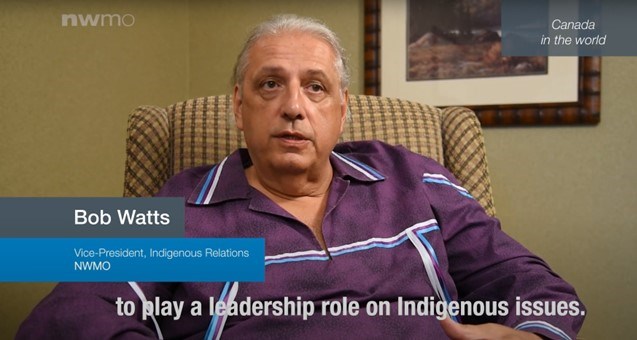IGNACE – Although COVID-19 put a hamper on social interactive work the Nuclear Waste Management Organization has been conducting since the beginning of the Deep Geological Repository project, NWMO has made advances in their policy to include Truth and Reconciliation: Calls to Action number 92.
For those who aren’t familiar with TRC’s Calls to Action 92, the Action states, “we call upon the corporate sector in Canada to adopt the United Nations Declaration on the Rights of Indigenous Peoples as a reconciliation framework and to apply its principles, norms, and standards to corporate policy and core operational activities involving Indigenous peoples and their lands and resources.
https://www.rcaanc-cirnac.gc.ca/eng/1524506030545/1557513309443
Call to Action 92 also includes that Canada must commit to meaningful consultations and informed consent of Indigenous people before proceeding with economic development projects.
Because NWMOs is a federal funding no-profit organization that was commissioned by the Canadian government to find a solution for the safe long-term storage of nuclear waste, NWMOs must have a reconciliation policy put in place to proceed with the DGR project.
“Status quo hasn’t served Indigenous peoples and won’t serve them well in the future. If we’re acting in a manner that is consistent with the status quo, we will not be successful as an organization. That’s our challenge, to change the way we’re doing business to ensure we are reflecting our commitment to Reconciliation,” said Bob Watts, Vice-President of Indigenous Relations and Strategic Programs at the NWMO.
The status quo to which Watts if referring is the treatment of Indigenous people and the treaty land. It is no secret that when it comes to TRC’s Call to Action 92, the governments of Canada across all three levels have much more work to do in building partnerships within treaty territories.
“The status quo is something we have been experiencing in Canada for generations,” Watts elaborates. “Often times that Indigenous People are being talked to last, not taking into account the rights of Indigenous People, and in particular, the specific world view that [doesn’t incorporate] Indigenous Knowledge and Indigenous Science that can be brought to bear on some of the toughest issues that we are dealing with. And if we do those things, to me we are doing things from a status quo perspective, and if NWMO is doing things from a status quo perspective, what I am saying is that we are not going to be successful.”
For Watt, the alignment of western views of science and Indigenous Science are crucial to the world NWMO is doing. Watt feels that staff needs to recognize that water isn’t just a combination of hydrogen and oxygen molecules but a living breathing organism that interacts with the environment in complex ways. Within those molecules hold the story of the land from its beginnings to its endings.
NWMO’s Reconciliation Policy requires all staff much have mandatory reconciliation training, as well as, provide additional opportunities to learn more about Indigenous knowledge systems.
NWMO’s Reconciliation Report states that “[t]o date, over 80 per cent of NWMO staff have completed the first two Reconciliation training modules, which include space for learning circles and Indigenous-led dialogue.”
These training modules include workshops run in partnership with NWMO’s Youth and Elder council where NWMO staff learned about Indigenous Knowledge systems that provide them with Indigenous perspectives on how to scientifically approach various fields of research.
Another highlight from the Reconciliation Report is that “10 per cent of staff identify as Indigenous” which is another piece to the Call to Action 92 which states that Canadian projects must “(e)nsure that Aboriginal peoples have equitable access to jobs, training, and education opportunities in the corporate sector and that Aboriginal communities gain long-term sustainable benefits from economic development projects.”
“I think we were very deliberate with trying to attract Indigenous People to the organization,” explained Watts. “I think other initiatives around the whole diversity, equity, and inclusion efforts in Canada. It’s not enough to just try to attract people. You have to have a safe environment for people to work within. You have to honour those folks you are trying to attract to the organization, and I think we have been doing those things. When I think about some of my fellow Indigenous colleagues at NWMO, most have been there for quite a while, and most of us feel pretty comfortable there in terms of how we are respected and how are particular types of expertise are honoured within the organization.”
For Watts, the NWMO has made a positive working environment for all their staff.
“I have been fortunate enough to participate in a number of Reconciliation assessments at the NWMO, which prompt thoughtful dialogue on how our work is contributing to Reconciliation if we have considered Indigenous perspectives, and how we are creating space for Indigenous voices,” said Chris Vardy, Director, Management System and Performance Improvement at the NWMO. “At first, it was difficult to find ways of addressing these questions, but with a little effort and practice, and with the tremendous patience and support of our Indigenous Relations team, we are finding new and creative ways to really make a difference in how we approach our work.”
Additional highlights from the Annual Reconciliation Report for 2021 include:
- 13 assessments of NWMO governing documents to ensure Indigenous voice and worldview are reflected;
- Four projects related to Reconciliation and relationship building completed by First Nation and Métis communities in the siting region, in partnership with local municipal communities;
- 11 per cent of new hires identified as Indigenous; and
- $5.2 million in Indigenous community-guided investments ($15.9 million to date).
